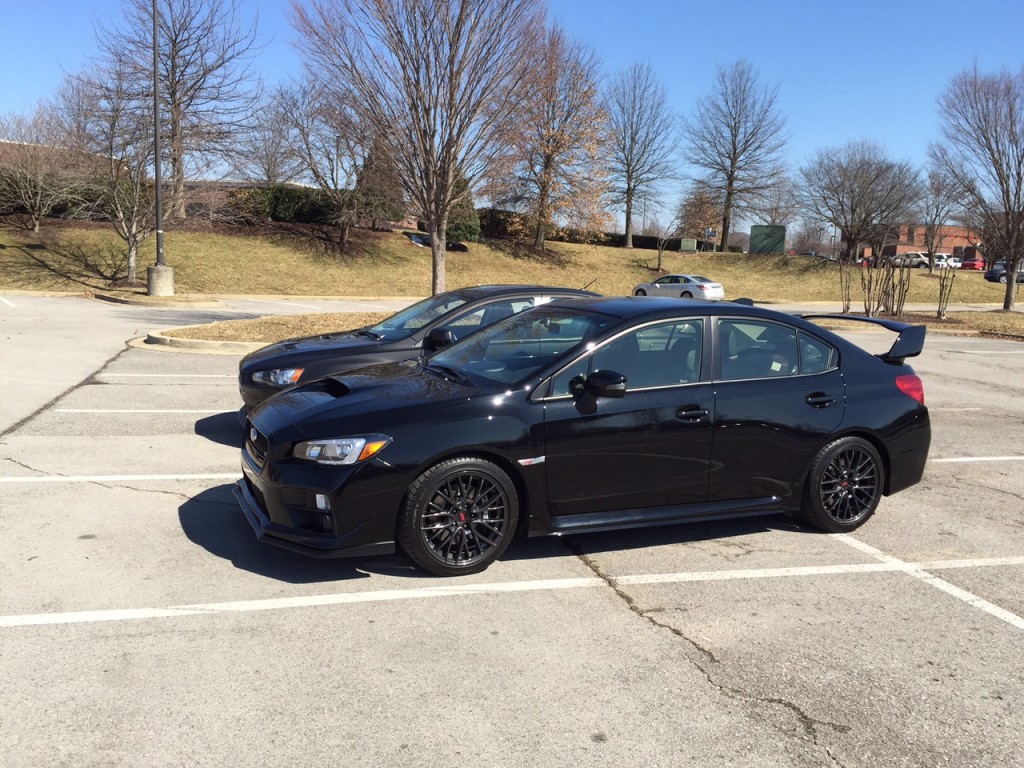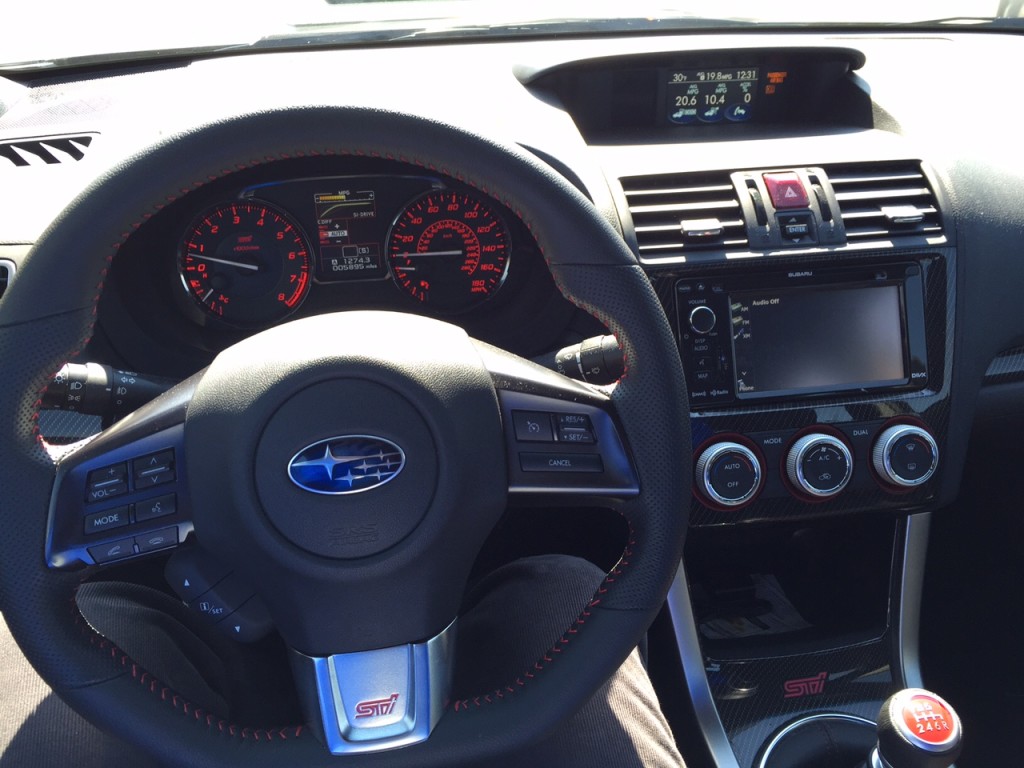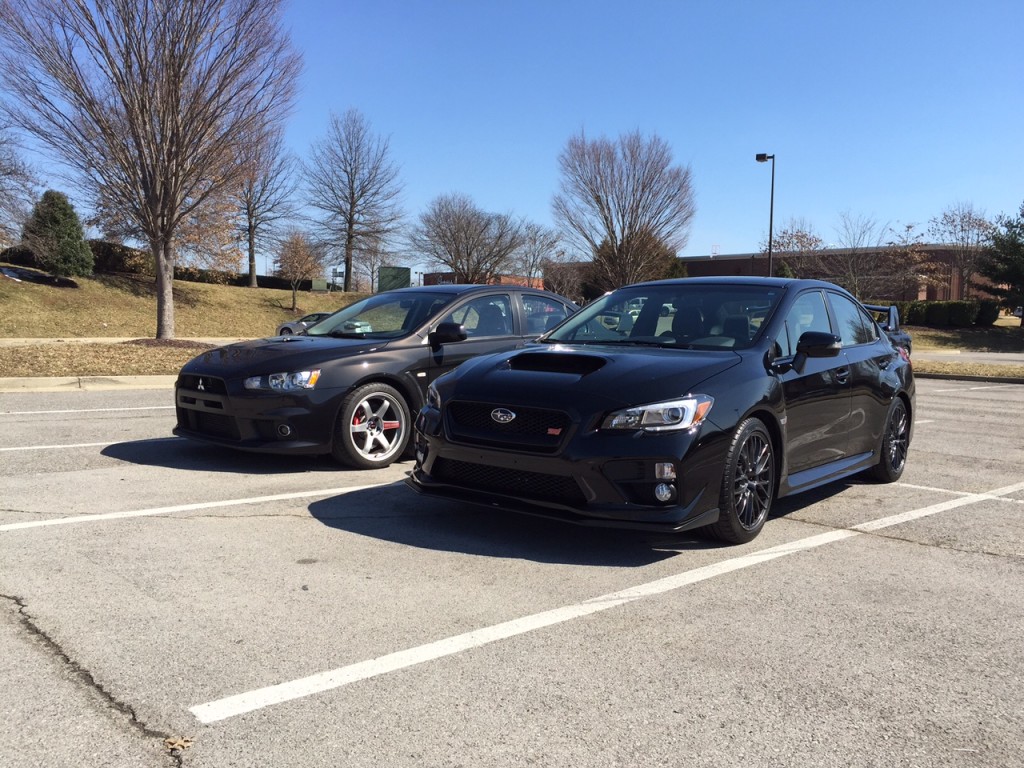Evo X vs. 2015 STI
2015 marks the last year of the Lancer Evolution, and the end of the rivalry with the WRX STI. These two cars have been in competition in various parts of the world since 1992 (1994 for the first STi). With the Final Edition, Mitsubishi is winding down a 23 year production run of the turbo all wheel drive sedan we’ve loved over the years. It seems only appropriate to pit it against its nemesis one last time.
A good friend of mine recently purchased a 2015 STI. It was a bit of a surprise, as he’s owned three Evos in the past, but it was time to try something different. This all-new STI is definitely larger that prior generations, which is obvious in physical dimensions as well as curb weight.
That extra weight isn’t something you’ll feel while driving. Although the heaviest STI ever built, it’s clearly the best one yet when considered as a performance driving machine. It feels more like an Evo than any Subaru I’ve driven, and that’s no small praise. Before the current iteration, the STI’s handling was much more prone to understeer, and substantially less precise.
The steering rack has been quickened, the chassis dramatically improved, the suspension tuning updated, and boy does it show! This car has poise and placement that completely caught me by surprise. It pulls this off with no rear yaw controller transferring torque. In fact, its “torque vectoring system”, doesn’t transfer anything, instead limiting excessive wheelspin up front by pulsing the brake to the inside wheel in a turn. Thankfully, this system is fully driver defeatable.
The interior in this car is more upmarket than the Evo. The gauges, displays, and controls are well laid out and nice. The seats are decent.
The transmission in the STI easily outclasses the Evo’s five speed box. It has an extra gear, and those gears are spaced better. Shifting feel is infinitely superior and much more positive, and it’s strength at handling torque is the stuff of legend.
Even at stock power, I found acceleration to be good. But the typical Subaru turbo engine niggles remain, as it still has an EJ257 under the hood. Documented reliability is suspect even with stock examples, and a turbocharged boxer-4 is far from the ideal platform to increase power beyond modest levels without drama, higher expense, and likely both. Small turbo, extreme packaging compromises for plumbing, low rev potential, and a top mounted intercooler are a few examples why big power STIs aren’t common.
The engine limitations aren’t enough to detract from the greatness of this car, though. The fact is, most owners will be happy a modest bump in power of 25% or so, and this is where the virtues of the STI shine brightest.
The Evo used for the purpose of this writeup is neither a Final Edition nor a 2015. It’s my personal 2013, and has been highlighted as an Evolutionm.net project car in the past. With 17k miles on the clock, it is still on the stock turbo with full bolt-on exhaust mods (minus downpipe), intake, IC with piping, and custom tune. It also has Ohlins R&T coilovers with different spring rates set up by CBRD Speedfactory, rear sway bar with end links, and aftermarket wider 9.5″ wheels wearing 265/35/18 summer tires. Grip is this car’s strong suit.
The main difference in the 2015 model and my 2013 is the lack of the Recaros in the 2015 US edition, something I don’t think I could stomach. Part of the charm of the Evo is that it becomes something incredible when considered as the sum of it’s parts, and charm is markedly diluted when saddled with Lancer seats. Canadians can rejoice, as the last year Evolution for the rest of the world will be equipped with Recaro seats from the factory.
The Evo X is long in the tooth, having been on the market for 8 years. That said, it is still more of the racecar of this pair in my opinion.
Drivability and handling differences with the STI aren’t the wide gap they used to be, but still noticeable. SAYC, the Evo’s rear torque transferring system/yaw control, is what ultimately makes it victorious in this category. The STI might be slightly more predictable to first time drivers of these cars, however, as you can coax the Evo into oversteer in a high speed corner. Don’t lift off the throttle, because you’ll spin. But once you make peace with SAYC and use it correctly, the Evo has higher corner entry and exit speeds. Wider rubber reigns in a bit of the oversteer, even if you commit too hot, and increases corner speeds even more.
Other performance bits that set the Evo apart from the STI are its aluminum roof and aforementioned Recaro seats. If track days are something you enjoy, it’s absolutely worth finding a pre-2015 US Evo, or replacing the 2015’s front seats. You can’t as easily drive the car to it’s full potential if you’re sliding around in the seat, and the Recaros hold you in place. Even better, they’re extremely comfortable. A friend and I drove an Evo X across the country over a couple of days and I didn’t have any of the lower back fatigue most passenger cars give me after a long time sitting.
The Evo reigns supreme on the aftermarket power side, with a larger turbocharger and front mounted intercooler stock. Adding simple mods, it makes more power than the STI, even while giving up a half liter of displacement. With an aftermarket turbo, increases of 150whp above stock and beyond aren’t a reliability problem for the Evo’s 4B11 with stock internals.
The STI is a great car, but the Evo is a better car. To consider myself biased would be an understatement. I’ve owned five Evos and one WRX over the years. In spite of that, I don’t think there’s a better turbo-AWD four cylinder sedan than the Evo for the money. The swan song of this fantastic car is nearing its last chorus. Resale values are incredible. It would be a shame not to pick a new one up while you still have the chance.





